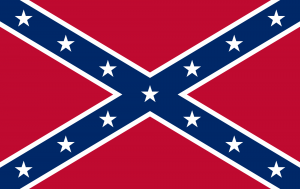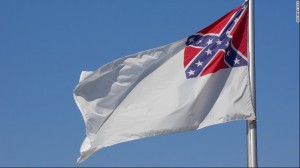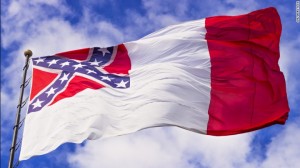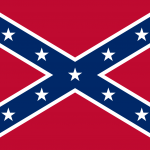( This column recapitulates the basic points about the swastika and Confederate flag made in my most recent Witches & Pagans piece, but with a different focus, some different information, and a complementary but distinct conclusion. )
_______
After the Charleston murders right wing media and politicians attempted to seize control of its interpretation. In response I wrote moral revulsion was the ultimate corrective to the totalitarian mindset. It and not intellectual argument could break the ideological trance that blinded adherents to such movements from being able to think for themselves when evaluating it. This is because ultimately we are beings of care more than beings of thought.
But I had no idea it would happen on such a scale.
Long mistakenly thought to stand for a region’s culture, a symbol of racism and violence is being rejected by many of the most decent who once so understood it. Others who long tolerated it are demanding its removal. The destructive myth of the Confederacy as having any redeeming features is finally dissolving for many Americans.
And yet there are sincere Southerners torn by what is happening because they continue to see the flag as a symbol for Southern culture.
Two Symbols: the Swastika and the Flag
Can a good symbol be ruined by bad events committed under its image? Can a bad symbol be used to symbolize admirable things? For many Pagans this issue is one we can more appreciation more than most. The swastika was long a powerful Pagan religious symbol. Yet today it is almost never seen in the West except when used by the spiritual and moral degenerates of the racist right.
In reality, as I will demonstrate the case for rehabilitating the swastika is far stronger than the case for using the battle flag as a symbol for Southern culture. Even so, as a society, we are not yet ready to rehabilitate it.
The Swastika: victim of the Nazis
The swastika has been used in religious contexts throughout the world, and has been for thousands of years. It is one of the most ancient symbols in human usage. It has long been prominent in Native American cultures and is commonly seen today in Navajo weavings. . The swastika is arguably the most positive symbol among Hindus, Buddhists, and Jains. and pre-Christian European spiritual traditions.
https://en.wikipedia.org/wiki/Swastika#/media/File:Ilkley_Moor_Swastika_Stone.jpg
In the West the swastika was long used in secular contexts as well. It was associated with good luck and well-being and as such prominently used in business, on postcards, and in art. It is a truly world-wide symbol filled with positive meaning. A town in Ontario was named “Swastika.”
https://en.wikipedia.org/wiki/Swastika,_Ontario
Today, outside some Indian tribes it is barely used in the West. Everyone knows why.
Today most people are unaware of the swastika’s true history. They associate it only with the crimes of Nazi Germany, an imprinting continually reinforced by the fascists using it as an honored in-your-face symbol for their depraved politics.
Not everything the Nazis did was bad. Like me and most of you, many Nazis had a strong appreciation for the natural world, and for protecting it. They actively discouraged cigarette smoking to preserve health. Compared to much of the world their autobahns and the Volkswagen (people’s car) were ahead of their time. Their social welfare programs were often very good ones – if in their eyes you were German.
But the context in which these good things were accomplished was unutterably depraved. It was associated with murder, genocide, tyranny, totalitarianism, aggressive war, and the wholesale theft of other peoples’ land and property. The Nazis were a criminal regime and the Nuremberg Trials brought an appropriate end to it, and to many of them.
Since the war this context has enabled critics of good things the Nazis did to discredit those things through guilt by association. An example that hits close to home for many of us are claims environmentalists are somehow connected to Nazism. Some have even suggested we Pagans are likely to become fascists, or already are at heart anyway.
Another less appreciated outcome of Nazi crimes was the desecration of a venerable and powerful Pagan symbol for a very long time to come. The swastika also suffers from guilt by association. In the West a little over ten years of Nazi rule poisoned a symbol that had been popular world-wide for thousands of years.
Few if any Western Pagans today would give the swastika a prominent place in our symbolism unless they are sympathetic to the Nazi regime. Sadly a few are. For the rest of us this perverse minority perpetuates the swastika’s association with depravity and blocks its rehabilitation as the positive symbol it was for thousands of years. We are well aware how easily seeking to revive the swastika would be misunderstood and most of us do not want to spend a lot of time defending its renewed prominence; which in many cases would not alleviate suspicions anyway.
The story behind the swastika’s meaning in the West is worth keeping in mind when considering today’s controversy over the symbolism behind the flag most associated with the Confederacy, the ‘Stars and Bars’.
The swastika easily comes out way ahead.
The Stars and Bars: victimizing Southern culture
The Confederate battle flag is defended today as a symbol of Southern culture, without anyone ever getting very specific as to what sets that culture aside as so different as to need that flag as a symbol. This evasion legitimizes something not worthy of that status and obscures what is truly admirable about Southern culture.
The flag’s original design placed the stars and bars in the upper left, the rest of the flag being white, symbolizing the white race. At the time the problem with this flag was not its symbolism, which was endorsed, it was that if the wind were not strong, from a distance it looked like a flag of surrender. So another version was designed.
http://www.cnn.com/2015/06/24/us/confederate-flag-myths-facts/
William T. Thompson, the white flag’s designer explained “As a people we are fighting to maintain the Heaven-ordained supremacy of the white man over the inferior or colored race.” After the war the flag fell into obscurity until the rise of the civil rights movement, whereupon it was returned to prominence by segregation’s defenders.
A lot happened in the South before the Civil War and also between its end and the rise of the civil rights movement, when the flag reappeared. Some was truly evil, as with the mass murder of Black Americans in 1921. But much is worthy of our respect and admiration. None of the latter is connected to the flag in any historical or political sense. Every culture provides a framework within which great good is accomplished and great crimes are committed. Unlike the South, most do not choose symbols of the latter to commemorate the former.
Southern culture is many cultures
The South as a whole differs culturally from the rest of this country, but itself is a mixture of many cultures. The culture of slavery, and the deformations of human decency it bred, runs like a poison through much of it. Yet much that is most admirable about Southern culture is the creation of people victimized by slaver society. Some is obvious, as with the South’s contribution of the Blues, Jazz, and Rock ‘n Roll to American culture. Other dimensions are less well known outside the South.
Southern agrarianism.
The southern agrarians were the most prominent Southern critics of corporate industry’s power, a power they believed had deformed the North. They were critical of the abuses of labor by Northern capitalists and praised the virtues of agriculture and small-scale communities. They admired the Jeffersonian ideal of a country dominated by small independent farmers and thought the US should seek to strengthen these qualities rather than dissolve them in an industrial and urban society. As the introduction to their most famous book. I‘ll Take My Stand, states, “The theory of agrarianism is that the culture of the soil is the best and most sensitive of vocations, and that therefore it should have the economic preference and enlist the maximum number of workers.”
Wendell Berry, whom I admire greatly, is a direct descendent of the Southern Agrarian tradition. Through Berry and similar authors this tradition has had an enormous impact on American farming insofar as it is not agribusiness.
The agrarians’ arguments were important early efforts to find a humane solution to the growth of corporate economic domination. They considered themselves – and were considered by others – conservatives. But unlike so-called ‘conservatism’ today they were anti-corporate and pro-small businesses and farms. Unlike similar criticisms on part of the anti-capitalist left, they sought to root their alternative in localism, face to face communities, cooperatives, and traditional values. Today most of these themes are often associated with the left. ‘Conservatism,’ like corporate liberalism, identifies with the corporate and banking world.
From this Pagan’s perspective their’s was a significant attempt to root our relations to land and place in more than instrumental commercial thinking. As capitalism gradually transformed life their perspective pointed towards a more humane alternative.
The first Southern Agrarians also accepted segregation and hierarchy between the races, but their racism was in no sense an essential element of their arguments. Racism was even more endemic to Southern culture than it was in the North, but not necessarily linked to face-to-face relations, agriculture, and smallness of scale. That is why Wendell Berry could so easily be their contemporary heir, though racism plays no part in his work.
In truth, the agrarian’s ideal was close to what had once characterized New England town’s and farms, that so captivated Alexander Tocqueville when he studied the new United States. They lacked, as they continue to lack, New England’s town meetings, but America’s primary theorist of a rural based democracy, Jefferson himself, wanted that New England institution transplanted to the South as “ward republics.” The agrarians saw in the rural South values and ways of life that had once widely characterized the US.
The racism and segregation they took for granted had different foundations.
Slaver culture
Plantations were not expressions of Southern Agrarianism. They were huge market based enterprises seeking to make their owners rich and using large numbers of slaves instead of free labor to do so. They were the spirit of capitalism applied to agriculture where workers were more profitable as slaves than as independent beings. They were the agribusinesses of their time.
Slavery was big business. Steven Deyle writes the value of slaves in the US was “roughly three times greater than the total amount of all capital, North and South combined, invested in manufacturing, almost three times the amount invested in railroads, and seven times the amount invested in banks.”
Southern industry used slaves and companies as well as individuals owned them. The Baltimore Iron Works was one of the largest industrial enterprises in colonial America. From the beginning it had used enslaved labor as a significant part of its workforce. Free workers, Black and White alike, were also employed, but records indicate slaves made up almost half the workforce.Using enslaved people in private industry was common in the South. While most slaves worked in the cotton industry, about 5% were owned or hired to work in factories, or in construction, mining, lumbering, and transportation. The South’s economy was largely agricultural because on balance cotton production was enormously profitable. But slaves were used wherever owners thought they could make money doing so.
Far from being pre-capitalist as so many on both left and right think, the Southern slave economy was deeply capitalistic and integrated with the North’s growing industrialization. Northern textile production played a central role in New England’s industrial development. Ronald Bailey writes “In 1860 . . . New England had 52 percent of the manufacturing establishments and 75 percent of the 5.14 million spindles in operation.” He added “New England mills consumed 283.7 million pounds of cotton, or 67 percent of the 422.6 million pounds of cotton used by U.S. mills in 1860.” This cotton was slave produced.
There were more millionaires in the Southern Mississippi valley than anywhere else in the country. Those millionaires became wealthy through huge agribusiness enterprises, not through small farms. The only difference between them and modern industrial capitalism was that they relied on slaves rather than wage labor.
American capitalism could have taken a Southern turn. Capitalism does not require free labor, and important elements of early American capitalism preferred slaves. Southern economic elites argued slave labor was intrinsically superior to free labor. Anywhere. Ideally the North would be slave as well as the South. Consider these words from an 1856 issue of the Muscogee Heralld cited in an excellent article by Ta-Nihsi Coates.
Free Society! we sicken at the name. What is it but a conglomeration of greasy mechanics, filthy operatives, small-fisted farmers, and moon-struck theorists? All the Northern men and especially the New England States are devoid of society fitted for well-bred gentlemen. The prevailing class one meet with is that of mechanics struggling to be genteel, and small farmers who do their own drudgery, and yet are hardly fit for association with a Southern gentleman’s body servant. This is your free society which Northern hordes are trying to extend into Kansas.
This is not the language of the small farmer, it is that of the lordly aristocrat, a parasite on the labor of others strutting around as a ‘gentleman’. For those familiar with his work, compare these views with Alexander Tocqueville’s admiring description of the North during this time.
Advocates of slavery were vocal on how slavery was superior to free labor not just in the South, but everywhere.
For the economic elite that the slaves were Black was less important than that they were slaves. The leading South Carolina Democratic paper supporting the pro-slavery James Buchanan for the 1856 presidential election wrote
Slavery is the natural and normal condition of the laboring man, whether white or black. The great evil of Northern free society is, that it is burdened with a servile class of mechanics and laborers, unfit for self-government, yet clothed with the attitude and power of citizens. Master and slave is a relation in society as necessary as that of parent and child; and the Northern states will yet have to introduce it. This theory of free government is a delusion.
The Richmond, VA, Enquirer wrote
Repeatedly we have asked the North ‘has not the experiment of universal liberty failed? Are not the evils of a free society insufferable? . .
These attitudes were also present in slavery’s Northern supporters. Two papers supported Buchanan in New York City. One, the Day Book, supported re-establishing and expanding slavery as the solution to white poverty:
Sell the parents of these children into slavery. Let our legislature pass a law that whoever will take these parents and care for them, and house them – shall be legally entitled to their service; and let the same legislature decree that whoever receives these parents and their children, and obtain their services, shall take care of them as long as they shall live.
Had the South won the Civil War these same interests hoped to expand slavery through military conquest in the Caribbean and Mexico. This had been a long term goal of slaver elites. In 1848 Jefferson Davis had argued after the Mexican American War Cuba “must be ours” to “increase the number of slaveholding constituencies.” Albert Gallitan Brown, one of Mississippi’s most influential citizens, who founded its univeristy, argued in 1858 “I want a foothold in Central America… because I want to plant slavery there…I want Cuba,… Tamaulipas, Potosi, and one or two other Mexican States; and I want them all for the same reason – for the planting or spreading of slavery.”
It was in service to their interests that the Civil war broke out with the firing on Fort Sumter. It is these interests that the stars and bars honors and symbolizes. It had nothing in common with the most basic views of the Southern agrarians.
Southern culture involves more than agrarian and slaver ways of life. It includes religion, where there is a deep difference between the Black churches and White denominations that arose in explicit defense of slavery. It includes its musical heritage which is even more diverse, but with no significant slaver contribution. And more.
But the essential faultline dividing Southern culture is that between the bulk of residents and slaver domination, a dividing line blurred by the acceptance of racism by so many of the former, that blinds them to their status as permanent underlings of plantation agribusinesses. Today the same faultline exists between the American people as a whole and the world of corporate and financial power. Ironically, just as race was used by slaver society to divide those not part of the commercial aristocracy, the corporatists today use cultural divisions to divide Americans and preserve corporate power.
As the lie equating the culture of most Southerners with the values of the Confederate battle flag dissolves, perhaps more Southerners will see what they share in common with most of us, a shared interest being assaulted by corporatist elites in both parties.
The swastika and the flag
The case for rehabilitating the swastika as a European religious symbol is far stronger than the case for flying the Stars and Bars as a symbol of anything good about the South. The swastika’s symbolism has been positive far longer than it has been negative.
The ‘Stars and Bars’ origins were in affirming the value of slavery and White supremacy. It was the battle flag in a war that ultimately killed at least 600,000 Americans. It represented a moneyed elite that stood in opposition to and dominated the other elements of Southern culture I described. It continues to inspire and give a stronger sense of legitimacy to the authoritarian racists who provide the cultural framework within which young people like Dylan Roof are poisoned and turned towards hate and murder. It symbolizes a social and political order standing at cross purposes with those parts of Southern culture that are most deserving of our respect, admiration, and even adoption by other parts of the country. Relying on most Southerner’s ignorance of the darkest sides of their history, those who treasure that dark heritage seek to slander the South as a whole by making it stand for them all.
It is long past time for it to go.






















